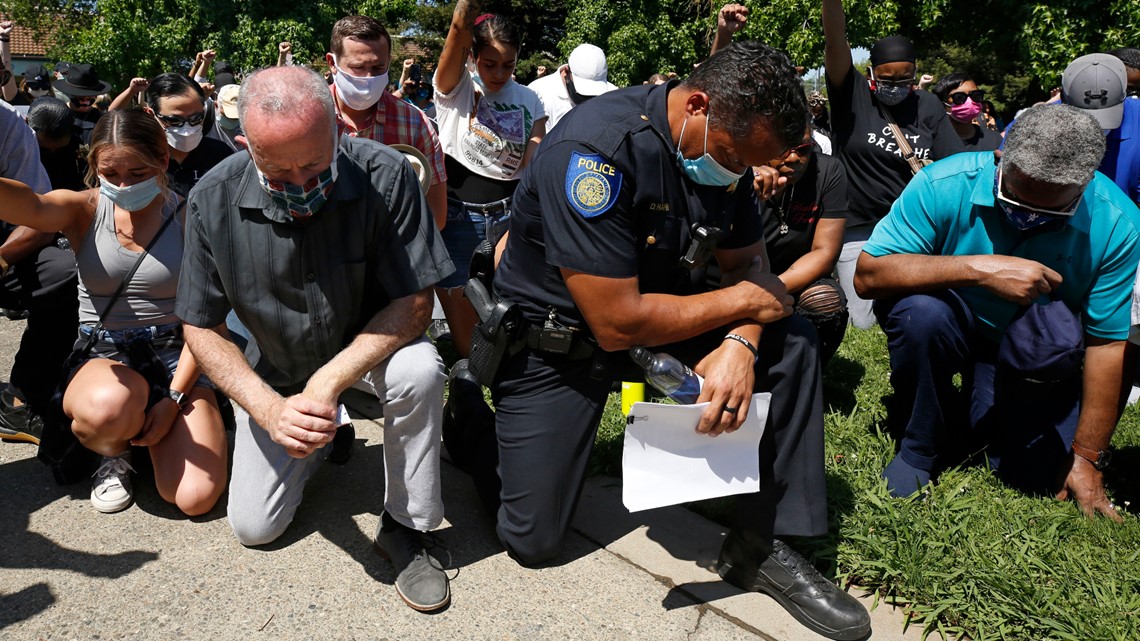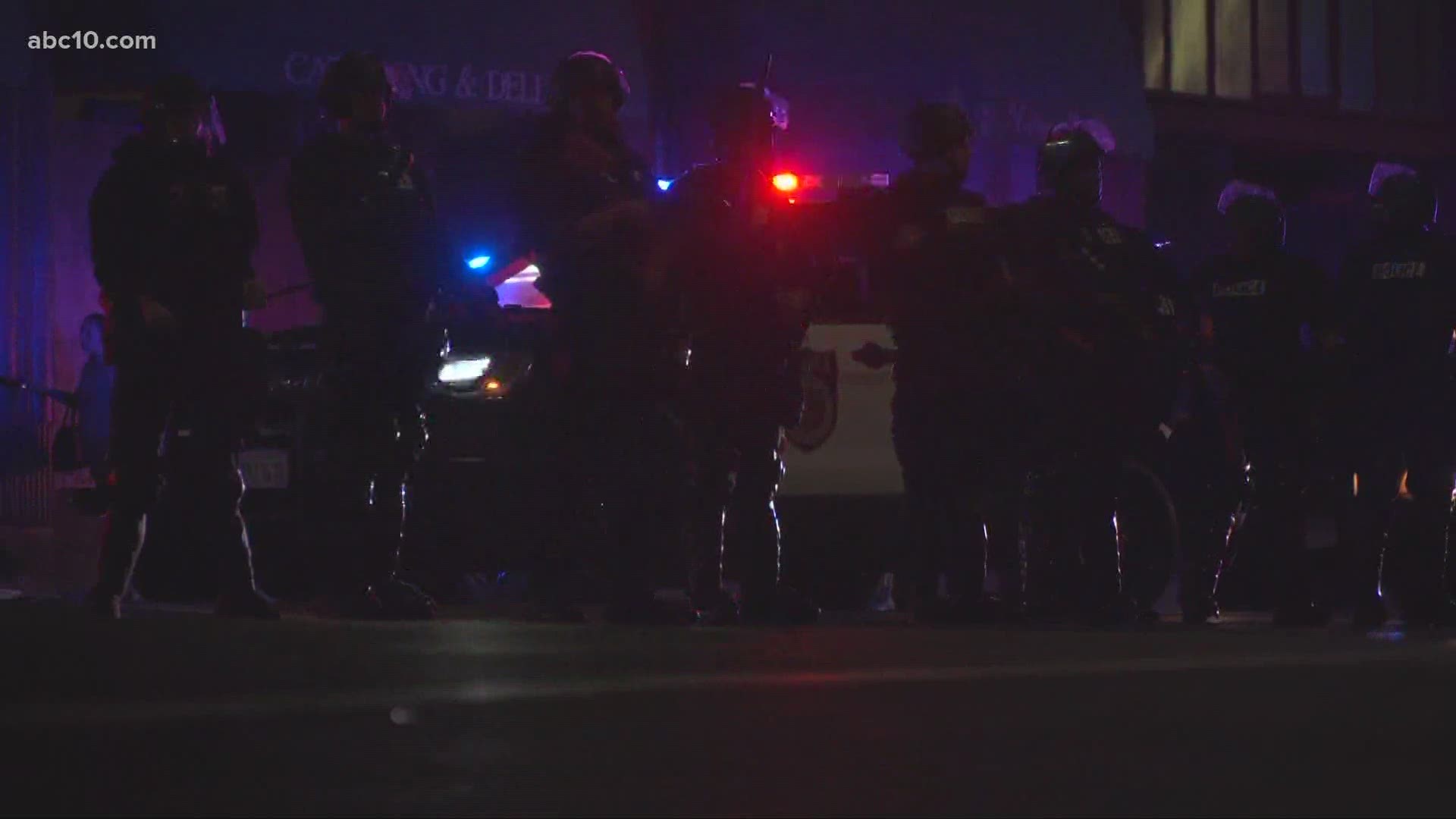SACRAMENTO, Calif. — In his first action after nearly two weeks of protests calling for police reform, Governor Gavin Newsom on Friday ordered the state police training program to stop teaching officers how to use a hold that can block the flow of blood to the brain.
The announcement comes as Campaign Zero, a national police reform organization, pushes its "8 Can't Wait" project which claims eliminating eight specific police policies would drastically decrease police killings.
"Protesters have the right to protest peacefully, not to be harassed. Not be shot at by rubber bullets or tear gas," Newsom said during a press conference on Friday. "Today I am calling for the creation of a new statewide standard for use of force in protests. Acts of violence against peaceful protesters will not be tolerated."
Newsom's call to eliminate specifically the teaching of the carotid hold to officers would only ban the use of a specific hold, and not chokeholds and strangle holds.
There's also the question of how the state would be able to enforce the ban.
In Sacramento, while police have yet to ban the carotid choke, they have stopped implementing the use of regular chokeholds.
But a video posted on social media Monday appears to show a Sacramento police officer use the same chokehold that has since been banned from the city's force. The officer appeared to use the hold on a teenager following a day of peaceful protesting in response to the police killing of George Floyd in Minnesota.
(Warning: The following video contains graphic content and language.)
The video, which has since been widely circulated on social media, shows Tyzhon Johnson, 18, being held in a neck restraint and pinned by officer past curfew Monday night in Downtown Sacramento, as a hostile crowd surrounded them.
The Edison High School class of 2020 graduate can be heard shouting "I can't breathe."
"I started slapping the wall trying to tap out, trying to let him know, like, 'Hold on, you don't have to do all this,'" Johnson said.
Zakiyah Guillory, 27, who filmed the incident, says she stepped in knowing George Floyd uttered the same words before dying a week before before.
RELATED: 'You changed the world George': Floyd's memorial service in Minneapolis marked by calls to action
"I'm like in fear that they're going to kill him, Guillory said. "The same exact thing. The reason why we're protesting."
Bonded in this moment, they're demanding the ban of "Carotid Restraint Control Holds," the same type of hold that Newsom said he's working to ban entirely.
And on Friday, following Newsom's announcement, Sacramento Mayor Darrell Steinberg echoed the governor's words.
"I support the statewide removal of the carotid hold as an allowable police tactic," Steinberg said on Twitter.
But Timothy Davis with the Sacramento Police Officers Association, said the carotid restraint is not a chokehold, and without it, officers could have a difficult time arresting people.
"If an officer is not allowed to use the carotid restraint they are going to have to use a different tool to take a violent subject into custody," Davis said. "You know, they may have to use their firearm or a taser or a baton."
The hold is a use of force allowed for properly trained officers to use, according to Sacramento police orders, when someone is being "assaultive," and it "appears necessary to prevent serious bodily injury."
The exceptions allowing for carotid restraint control holds remain, although the California Department of Justice recommended this policy should be banned.
"It's complete ignorance to continually employ a tactic that your department is already told you to stop employing," Johnson said.
Banning chokeholds and strangleholds is among eight policies, that together can reduce police violence by 72%, the "8 Can't Wait" project claims.
The policies were identified as meaningful ways to establish restriction on how and when police use force against civilians. A 2016 study identified these policies compared use-of-force policies with police killings data from 91 of the 100 largest police departments to determine the relationship between the two.
RELATED: Mayor Steinberg said Sacramento curfew could be modified this weekend, but the ACLU demands it end
The study found that "police departments with policies that place clear restrictions on when and how officers use of force had significantly fewer police killings than those that did not have these restrictions in place."
Davis said Sacramento police have already banned the use of chokeholds, as have many other departments in the state.
"We're always open to have these conversations," Davis said. "The Sacramento Police Department has always been on the cutting edge of our policies."
But how does the Sacramento Police Department stack up against the "8 Can't Wait" policies? They're certainly not perfect.
ABC10 reviewed the Sacramento Police Department's general orders, which were updated last September after the shooting incident of Stephon Clark spurred state-recommended reforms.
ABC10 found the department enacted five of the recommended "8 Can't Wait" policies, but it has not adopted a use-of-force continuum, does not completely ban shooting at moving cars, or ban all types of chokeholds.
The department also has not enacted all recommendations outlined by the California Department of Justice last January.
Carotid restraint holds have been a controversial tactic, that the California Department of Justice has called "needlessly high risk."
A spokesperson for Sacramento Police Department, responding to Johnson's arrest, told ABC10 in a statement that "Officers attempted to detain the man, but he fled on foot. A foot pursuit ensued where the suspect then began to resist officers. A large crowd began to gather and became hostile towards officers. Johnson was arrested on looting charges and resisting arrest."
Police did not mention the chokehold seen being used in the video.
It's an account, Johnson is challenging. He says he was sitting outside of the P.F. Chang's Restaurant when he first encountered officers.
"I was getting ready to go home. I was looking through my backpack for my phone and an officer pulls up on the sidewalk and he pulls up extremely fast, and he has full armor," Johnson recalled. "He starts moving fast, and he's a big person. So, at that rate, you think he's actually coming to get somebody. So instinctively my first instinct is to grab what you got and run because you don't know how it's going to end."
Johnson says after running he dropped his bag, tripped, and was on the ground when police caught up.
"I was already ready to comply. Like, I'm on the ground, I'm tired, there's really nothing I can do, and I didn't want to fight back. I did not have the strength for it," Johnson said. "So I fell to the ground. He jumped on me, flipped me over, and then started pulling my head up in a headlock, and I was like, "Hold on, your cutting off my ability to breathe."
Another angle, filmed by a bystander, shows Zakiyah Guillory get bum rushed by another officer while she's filming the incident, leaving her with deep scrapes and bruises.
While police officials say the crowd was hostile, she says she was not obstructing officers. Instead, she say officers obstructed her rights, and says she will be filing a lawsuit against the department, with famed civil rights attorney John Burris to represent her.
"There's a police officer guarding me from recording and not even intervening with her officer to get the officer off of him," Guillory said. "I was just recording and doing my piece, because I wasn't going to sit there and let him be another victim to police brutality,"
Guillory and Johnson said they are traumatized, but are speaking out to demand change.
"My community — we're tired. We're hurting," Guillory said.
They said they believe Johnson was targeted for the color of his skin and now faces two felonies and a misdemeanor charge in a court system that seems set up against the recent graduate.
"I was trying to figure out what I want to do, and all of a sudden, this giant setback? It's just not the way," Johnson said while shaking his head.


A spokesperson for the police department said in a statement that the incident "has been documented and will be reviewed per department policy as with any use of force."
Meanwhile, Steinberg says he wants further, public discussion about discussing banning all types of chokeholds.
"I've been informed that the incident in this video is being investigated to determine whether it complies with police department policy, which does not allow chokeholds and allows carotid restraint holds only to prevent serious injury or death to the officer or another person," Steinberg said in a statement. "I want to have a further, public discussion with the police department and the City Council about whether we should ban the use of all neck holds."
The City Manager oversees the police department.
However, Guillory, reacting to photos of Mayor Steinberg and Sacramento Police Chief Daniel Hahn kneeling in solidarity with protesters, says city leadership needs to do more and take steps to change policy.
"If they really want to make a difference in the Black community and make a difference to the people who are feeling like this, they should reach out and touch bases with them," Guillory said. "And not just do it for television or publicity, because that's what it seems like to me."
Kristopher Hooks, Samantha Solomon and Chris Thomas contributed to this story.
Follow the conversation on Facebook with Van Tieu.
FOR NEWS IN YOUR COMMUNITY, DOWNLOAD OUR APP:
►Stay In the Know! Sign up now for the Daily Blend Newsletter




